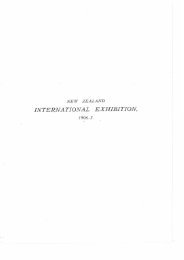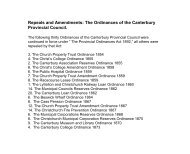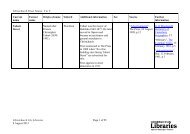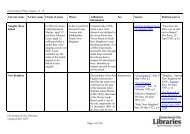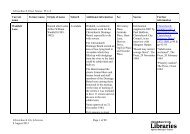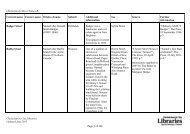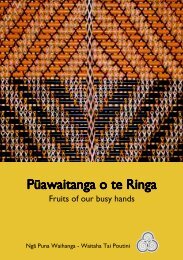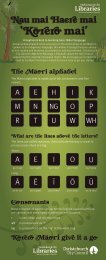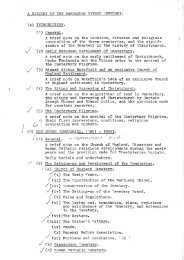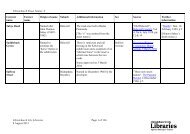Rich man, poor man, environmentalist, thief - Christchurch City ...
Rich man, poor man, environmentalist, thief - Christchurch City ...
Rich man, poor man, environmentalist, thief - Christchurch City ...
Create successful ePaper yourself
Turn your PDF publications into a flip-book with our unique Google optimized e-Paper software.
‘<br />
In 1870, the great animal,<br />
vegetable and mineral<br />
collection was made<br />
readily accessible to the<br />
public in the purpose-built<br />
stone museum in<br />
Rolleston Avenue. The<br />
staff consisted of ‘a<br />
director [Haast] ... taxidermist<br />
[Frederick] and a<br />
boy on a temporary<br />
engagement’.<br />
’<br />
18<br />
Glenmark moa<br />
skeletons articulated<br />
by F R Fuller.<br />
Weekly press,<br />
December 1900, p27<br />
The taxidermist and his superior found that, often, 25 to 30<br />
moa specimens were so closely packed together that the whole<br />
formed one mass. Nevertheless, the pair sat on the bank of<br />
the Avon, sorting the bones into different sub-species and then<br />
into individuals. It soon became obvious that, for the find to<br />
be shown off to best effect, new quarters would be required.<br />
Haast succeeded in taking over for museum purposes an<br />
attractive provincial council room on the first floor of<br />
‘Bellamy’s’, the stone structure in the provincial council<br />
complex which stands adjacent to the Great Hall and looks<br />
over the river. The museum headquarters, commonly known<br />
as the ‘coffee room’, would one day become the<br />
Superintendent’s office. The adjacent room – small and with<br />
a fine bow window – was Frederick’s work space. Using the<br />
contents of the original four-horse wagon and working in the<br />
‘coffee room’, the taxidermist articulated Canterbury’s first<br />
seven moa skeletons. When, in December 1867, the museum<br />
was opened to the public, these became a source of<br />
wonderment to the populace. For years they were ‘admitted<br />
to be the finest representative collection in the world’.<br />
In 1870, the great animal, vegetable and mineral collection<br />
was made readily accessible to the public in the purpose-built<br />
stone museum in Rolleston Avenue. The staff consisted of ‘a<br />
director [Haast] ... taxidermist [Frederick] and a boy on a<br />
temporary engagement’. For a time trustees ran the museum,<br />
after which <strong>man</strong>agement was handed to the Board of<br />
Governors of Canterbury University College. From 1874,<br />
Frederick’s name was included, along with that of the director,<br />
in the annual Southern provinces al<strong>man</strong>ac. The taxidermist also<br />
figured prominently in photographs on show at the museum.<br />
In one image he appeared with bushy beard, moustache and<br />
long soft flowing hair, a ‘figure out of the Ober-Ammergau<br />
passion play in mufti’. In another, he stood inside a whale<br />
skeleton. In awe did a child ask: ‘Mama, is that Jonah in the<br />
whale’s belly?’ More importantly, Frederick received the<br />
respectable salary of £200 per year.<br />
Frederick undertook a variety of tasks. When Haast was<br />
ill, he secured the skeleton of a stranded whale and made the<br />
necessary observations as to its dimensions, form, sex and<br />
age. When runholder and conservationist Thomas Henry<br />
‘Bellamy’s’, Canterbury Provincial Council complex. The room with<br />
the bow window was Frederick Fuller’s work space.<br />
Potts discovered a new species of gull, Frederick, hot on his<br />
heels, found specimens near the mouth of the Waimakariri.<br />
At Little Rakaia, Frederick and Haast examined the cooking<br />
places and kitchen midden of the moa hunters. Frederick<br />
excavated in and about the ancient Maori encampment at Moabone<br />
Point, Sumner, transferring to the museum, articulating



